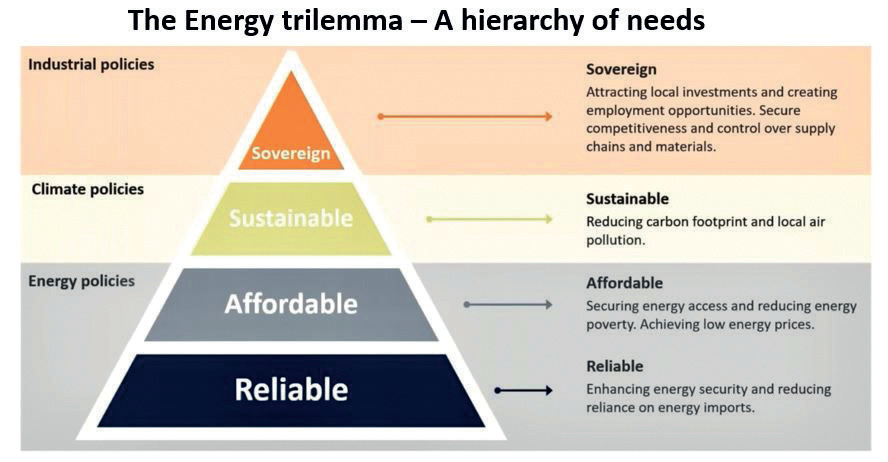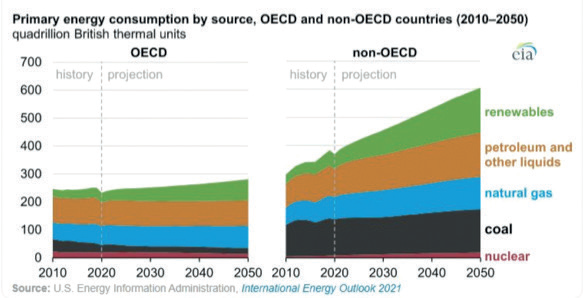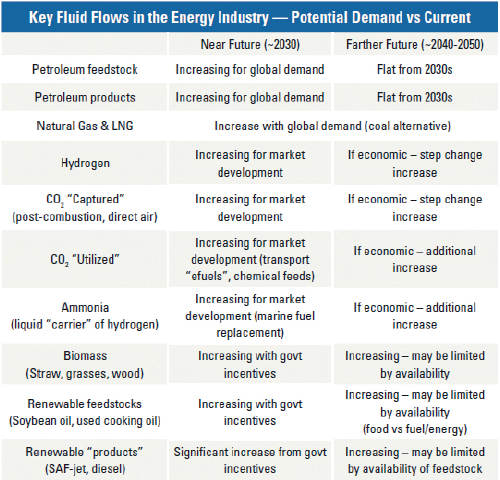The energy industry has been in a state of transition for two centuries, and there is no reason to expect that this state will stop within the next century, see Figure 1. While non-renewable carbon fossil fuels made unprecedented human prosperity possible during the last 150 years, the carbon emissions (GHGs) and carbon intensity from the use of nonrenewable carbon fuels must be reduced. Carbon is the key to life as one knows it and cutting carbon use to zero is impractical. However, it is paramount that the emissions generated from the use of carbon and the carbon intensity (tons of CO2 emissions per unit of carbon consumed) must improve.
By Tim Goedeker, Consultant
Although much has changed over time, the demand for pumps, heat exchangers, hose, piping, valves, and connectors has not, nor will it. What will change is the expectation and eventual requirement of ‘zero’ leaks (emissions), of carbon emissions to the atmosphere.
Ever since the transition from woody mass energy sources to fossil fuels, human activity has been putting increasing pressure on the atmosphere’s capacity to absorb and integrate greenhouse gases (GHGs). This scarcity of available GHG capacity has created a demand for another major shift in energy sources; this time, toward less GHG emitting ones. The transition to a low carbon economy depends on the substitution away from non-renewable carbon fossil fuel energy toward no-carbon, or renewable carbon energy sources.
Significant Changes Required
The transition to a sustainable low carbon economy will require radical changes to systems for providing energy and other services for individuals, communities, and businesses. This will involve changes to practices of energy use; innovation and deployment of a range of low carbon technologies; and broader change in the mix of industries within national and global economies. To be successful, these changes need to contribute to maintaining and widening economic prosperity in a socially equitable way, while ensuring that these socio-economic systems remain within ecological limits.
There lies the energy trilemma: providing energy that is affordable, reliable, and with fewer carbon emissions, see Figure 2.


The main economic drivers for prior energy transitions were the opportunities to produce cheaper or better energy. The existence of a niche market willing to pay more for the new energy sources and technologies enabled them to be refined gradually until they could equal or exceed the incumbent energy source. This process, on average, took at least 50 years.
The transition to a low-carbon economy is different. It is not driven by an economic benefit, and it is anyone’s guess how long the transition will take. History may not be a guide. However, because of consumers’ tendency to free-ride, a successful transition will need governments to provide ‘protection’ – incentives, tax credits – for the low-carbon energy niche market – likely for decades. Based on past experiences, a complete transition to a low carbon economy is likely to be very slow.
Reducing Emissions
The view that petroleum (oil & gas), volumes will continue to play a vitally important role in global energy markets for decades to come has gained new advocates through the early 2020s. Global energy demand and population is expected to increase 50% through 2050, see Figure 3.

The oil & gas industry has undertaken a major strategic shift, embracing the global push to reduce carbon emissions by, among other things, emphasizing the greener emissions profile of natural gas vs. coal. At the same time oil & gas producers, processors, transportation companies, and others have been facing an increasing pressure to slash — even eliminate — methane and other greenhouse gases (GHGs) emitted as oil & gas make their way through the supply chain, from the production well to the end user.
Significantly reducing and even eliminating methane emissions has seen the greatest global support. Methane, considered a ‘short-lived’ GHG, is a very potent climate pollutant — 86 times as potent as CO2 over a 20-year time horizon. That means, pound for pound, methane emissions have an outsized near-term impact on carbon emissions in the atmosphere. The good news is that methane has an atmospheric life of only 12 years, which means that reductions in methane emissions made today will have a much quicker near-term and more sizable effect than equivalent CO2 emission reductions.
Looking Forward
The more one hears about developing low carbon technologies and witnesses early progress, the more it is evident that there is a need to reduce the carbon intensity of the existing operations too. As mentioned earlier, historically energy transitions have taken at least five decades to fully realize the improvement beyond the incumbent energy system. While novel technologies for non-internal combustion engine (ICE), no carbon emission vehicles, will continue to grow and mature, demand for liquid fueled ICE vehicles will continue for decades. The future ICE fuels will, however, likely have a significantly lower carbon intensity compared with fuels used today.

The development of carbon dioxide removal (CDR) technologies (nature based & technology based) to remove CO2 from the atmosphere will multiply. As will no-carbon technologies to produce hydrogen and ammonia as replacements for petroleum sourced energy. With a projected 50% increase in global energy demand over the next 3 decades, demand for both non-renewable fossil carbon and renewable carbon sourced energy will increase, see Figure 3. The key to the success of the low carbon economy energy transition is the ability of energy generators and consumers to lower their generation of carbon emissions (GHGs), their carbon intensity, while new, innovative renewable technologies progress through the project development process and mature into viable energy sources, see Figure 4.

Lowering the carbon intensity of our legacy non-renewable carbon energy sources (especially the methane supply chain) is the bridge that literally will keep the lights on 24/7 while new technologies become proven. Numerous sources on the world wide web provide the following insights on potential changes in demand for fossil and renewable energy sources, see Table 1.
Final Thoughts
Carbon is the key to life as we know it and cutting carbon use to zero is impractical. However, it is paramount that the emissions generated from the use of carbon and the carbon intensity (tons of CO2 emissions per unit of carbon consumed) must improve. The low carbon economy will not happen overnight, regardless of the hyped sense of urgency, and will not be fully implemented until well into the last quarter of this century. However, the bridge to the ultimate low carbon world, for the next 2-3 decades, is to lower the carbon intensity of the legacy non-renewable carbon energy sources, with an acute focus on the methane supply chain. This bridge will literally keep the lights on while new technologies become proven.
Remember this – “The proper function of man is to live, not to exist. I shall not waste my days in trying to prolong them. I shall use my time.” – Jack London.
References:
- https://www.sciencedirect.com/science/article/abs/pii/S0921800911002898
- https://www.sciencedirect.com/science/article/abs/pii/S0301421512006805
- https://www.sciencedirect.com/science/article/abs/pii/S0301421510004921



